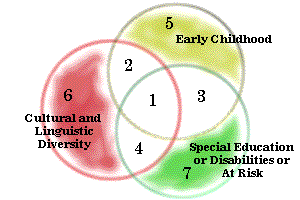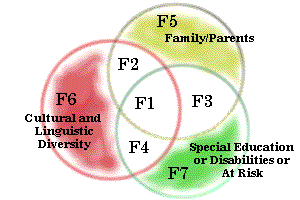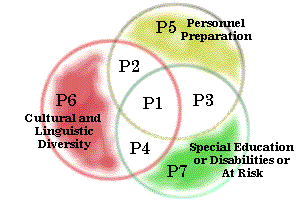Federal funding for this website ended in 2003, therefore few materials have been added since that time. Fortunately, there is continued interest in culturally and appropriate materials, curriculum, and programs. Because of this, we have allowed this site to remain as an archive. Please feel free to use this site, but recognize that it is no longer current.
Review of Materials Submitted to the CLAS Institute
- About Field Reviewers
- Overview of Cataloging and Review Process
- Criteria for Acquisition
- Special Collections
- CLAS Review Guidelines
- Search CLAS Materials
About CLAS Field Reviewers
We identified and recruited potential field reviewers from all over the United States and its territories. CLAS collaborators selected our field reviewers. We selected our reviewers from a pool of 200 using the following criteria:
- Extent of work and involvement with different culturally and linguistically diverse groups in various settings and locales;
- Knowledge on a range of early childhood and special education topics;
- Reviewers' cultural or linguistic background;
- Relationship either as a parent or sibling to an individual with a disability;
- Current work setting; and
- Current geographical location.
Our cohort of reviewers represents 30 states and US territories (Puerto Rico and Virgin Islands). The majority of our field reviewers have self-identified as a member of one or more cultural and linguistic groups including, Argentinean, Hmong, Japanese, Mexican, Navajo, Pilipino, Pueblo, Puerto Rican, Kootenai, Haitian, and West Indies/Caribbean. 40% of our reviewers are either a parent or sibling of a child with a disability, or themselves have a disability.
Finally, the majority of our reviewers provide direct services to children and families in various settings. They indicated expertise in a variety of topics relating to early childhood, special education, and diversity. All of the reviewers have experiences working directly with groups representing diverse cultural and linguistic backgrounds.
Biographical sketches of our field reviewers are available before each of their reviews.
Overview of CLAS Cataloging
and Reviewing Process
Acquire Material
CLAS acquires materials from various national, regional, state and local organizations, grant-funded projects, national, state and local programs, and publishers. To know more about our acquisitions process, see Submitting Materials to CLAS.
Catalog Material
When we receive a material from a developer or publisher, the long process of screening begins with cataloging. CLAS staff based at the Council for Exceptional Children (CLAS/CEC) catalogs the material and sends a copy of the material to the CLAS office based at the University of Illinois at Urbana-Champaign (UIUC). AT CLAS/UIUC, we continue the cataloging process by identifying the topics which the material covers.
Conduct Internal Review of Material
We begin our review process by conducting an internal review of the material to determine if it is appropriate for inclusion in the CLAS database, and if the material is appropriate for external review. Materials we include in our database address two or more of the following areas: (1) early childhood; (2) special needs or at-risk; and (3) cultural and linguistic diversity. Furthermore, these materials are practical and useful to families, practitioners, administrators and teacher trainers. See Criteria for acquisition (including Venn diagrams).
Conduct External Review of Material
Once a material is selected for external review, we contact the developer or publisher of the material to gather information about the development and evaluation or field testing of the material. We select two reviewers from our panel of highly qualified reviewers to review the material. The two expert reviewers each write a review of the material considering its cultural and linguistic appropriateness, congruence with current recommended practices, and effectiveness of presentation.
Conduct Review of Reviews
Once the reviews of the material are completed, members of the CLAS faculty review the reviews to insure their fairness. As Associate Editors, our faculty recommends inclusion of the reviews and material in the database.
As a matter of policy, CLAS is only posting materials that have received POSITIVE reviews.
For materials that are not included in the reviewed materials section of the database, choose: Described Materials.
Edit Reviews of Material
Our Editor completes the reviewing process by making sure that the reviews follow writing guidelines we have specified.
Send Reviews of Material to Developer or Publisher
Edited reviews are sent to the developer or publisher for their perusal. The developer or publisher is encouraged to write a response to the review to be added to the Web site.
Post Reviews and Material in the Web site
Edited reviews of materials are posted in the Web site along with relevant information about the material. When available, complete or partial text, video/audio clip, and web site address are included along with the reviews.
Criteria for Acquisition:
The broad parameters will indicate materials which...
- Deal with culturally and linguistically diverse populations,
- Are primarily concerned with children ages birth through age five and their families,
- Are concerned with children with disabilities or children at risk and their families,
- Are of a practical rather than theoretical nature

Materials which meet the criteria for content in all three areas: Early Childhood, Special Education/Disabilities/At-Risk, and Cultural and Linguistic Diversity would be classified as number 1, and included. Materials which fall in the combinations marked as 2, 3, or 4 would be included, subject to review by staff.
Items which are concerned with either Early Childhood (5), or Cultural and Linguistic Diversity (6) or Special Ed/Disabilities/At-Risk (7) would probably not be included, but if there is any question about whether or not the materials should be evaluated, an abstract of the article, material, etc., will be forwarded to the evaluation staff at the University of Illinois.
Except for category #1, the defining attribute will be that the materials are of practical rather than theoretical nature. This will govern the decision for inclusion.
1 Absolutely included
2,3 Yes to inclusion
4 May be included (Must be practical rather than theoretical)
5,6,7 Iffy
The same criteria will be applied to materials which focus on parents or families, rather than early childhood, and to materials related to personnel preparation. Here are the adapted Venn diagrams to illustrate this:

Following the above guidelines, materials classified as F1 would be included; F2, F3, F4 would probably be included; F5, F6, F7 would probably not be included.

Following the above guidelines, materials classified as P1 would be included; P2, P3, P4 would probably be included; P5, P6, P7 would probably not be included.
